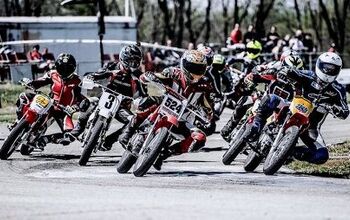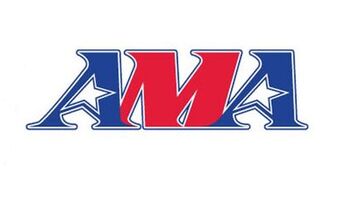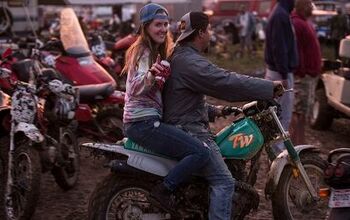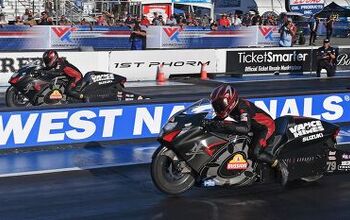Bike Week Vintage Road Racing
Their t-shirts proclaim undying loyalty to long dead brands: Norton. BSA. Vincent. Indian. They tear up at the sight of an Amal carburetor or a Lucas electrical bit. They form a sea of white and grey hair, tattoos long gone green and hands permanently stained by engine grease, lining up like teenagers at a pop concert to get the autographs of men who haven’t competed in racing for decades.
They arrive in their own style as well; Harley Knuckleheads with sidecars, four-cylinder Hendersons, 100,000-mile BMWs and motorcycles that look like they haven’t been cleaned since they were manufactured in the 1940s. For pit bikes, they ride Honda TL trials motorcycles. Without a doubt, vintage road racers and fans are unlike any other in the world.
For nearly two decades, on Monday and Tuesday of Daytona Bike Week, the infield paddock of the Daytona International Speedway is overrun with vintage racing fans and riders. The American Historic Racing Motorcycle Association (shortened to AHRMA and pronounced “arm-uh”), a member-owned non-profit sanctioning body, is responsible for the vintage racing festivities at Daytona. Formed in 1989, AHRMA has grown to nearly 6,000 members and holds 11 different race events throughout the season. They also sponsor vintage motocross, trials and dirt-track events.
They’re reliving their own history by coming here and watching or riding," said Cindy Cowell, AHRMA executive director and road race coordinator, of vintage race fans.
Although not the largest vintage event that AHRMA hosts, the Daytona races are the most popular among both competitors and fans. This year’s event had 300 racers. The mystique of racing at Daytona brings AHRMA racers from around the world, including a contingent from the U.K. with their old British iron and Japanese competitors who had crated and shipped their Kawasaki Z1 superbikes and flathead Harleys to Florida to race.
There’s nothing quite like the plodding sound of idling flathead engines waiting for the green flag or the roar of open megaphones as British Twins come off the Daytona banking. Indian Scouts to Manx Nortons, bevel-drive Ducatis to Honda CBs, it’s hard to find an unrepresented part of motorcycle racing history.
“It’s basically everything you’d see in a museum, but here you see them in action,” Cowell said.
But “vintage” doesn’t mean you can’t have overhead cams or fuel injection. AHRMA has become a foster parent to the Battle of the Twins class after the AMA discontinued it. They also host a Sound of Singles class for modern Thumper racers and a Sound of Thunder class, which is a class open to nearly any type of engine. It’s AHRMA’s attempt to get single- and twin-cylinder classes back into contemporary American road racing in what they call their “post-vintage” classes.
"It’s basically everything you’d see in a museum, but here you see them in action"
“Our racing includes bikes from 1939 to 2008,” Cowell said. “In AHRMA you can race almost any type of motorcycle.”
The range of motorcycles is matched only by the diversity of the riders. On Tuesday, former World Superbike World Champion Doug Polen was there, fresh from his second-place finish in the previous day’s Moto-ST event, racing on a Ducati 1098. Some racers were younger than the machines they pilot on the banks. Other competitors were on the same models they had raced at Daytona decades ago.
Ed Sensenig relaxed in a camp chair in front of his garage moments after finishing his first race of the day, his white hair a sharp contrast to his contemporary leathers. A few steps away sat a 175 Ducati Single like the one he raced at Daytona 50 years ago. Most vintage riders have a special connection with the motorcycle they race, a love that is necessary when it comes to keeping their machines running.
“They’re high maintenance and you have to expect to put in a new rod every year,” Sensenig said of his vintage race bikes.
Sixty-nine-year-old Sensenig made his first trip to Daytona from his home in Pennsylvania in a 1957 Volvo, stopping for 18 cent gas along the way to races that were then held at the airport. He later continued racing at Daytona as an AMA pro on Triumphs and BSAs.
“I love this place,” Sensenig said of Daytona. “I’ve come here for so many years, it feels like my track.”
And in this statement, Ed Sensenig speaks for all vintage racing riders and fans who will find the time each year to head south and help AHRMA keep American motorcycle road racing’s history alive and well on the banks of Daytona.
For more information about AHRMA vintage racing, see: http://www.ahrma.org/.
Related Reading
Hansen Dam Show and Ride
32nd Annual El Camino Bike Show
2007 MotoClassica
More by Jeremiah Knupp



























Comments
Join the conversation